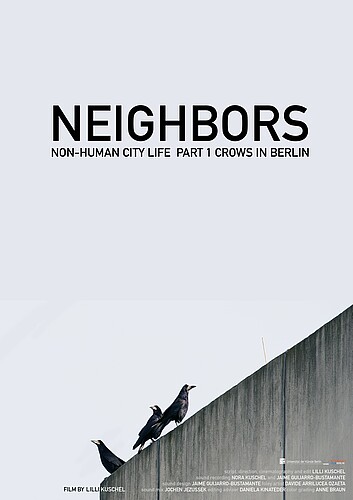Lilli Kuschel
Neighbors: non-human city life (part I, crows in Berlin)
Neighbors by Lilli Kuschel is an experimental documentary whose protagonists are Berlin crows. The video work attempts to seize their habits, rhythms, and ways of communicating in a loud city undergoing rapid urban development and expansion. It is the first episode of a body of work exploring non-human city life around the globe.
In Kuschel’s artistic practice, filmmaking is an act of sensing and making sense of the world through observation. Neighbors emerges from the artist’s fascination with crows, the desire to make contact with the other, and the long hours of lens-based birdwatching spent examining their lives in silence. In the artist’s words, “their community seemed like a parallel society next door that I knew very little about. I wanted to get to know my wild neighbors and see Berlin through their eyes to get a new perspective on my hometown. Filming wild birds was a huge challenge, since they can fly away—out of the frame—anytime.”
In an effort to experiment with post-anthropocentric ways of filming, Kuschel disappears behind the lenses and becomes a mimetic film director who lets the birds take the stage. Communication and movement patterns seem to emerge, as they usually do if we pay enough attention. However, the work carefully avoids explaining or dramatizing the images—in fact, no music, text, or human dialogues are added—presenting instead a montage of selected shots that create multiple possible stories whose unfolding is open to the interpretation of the viewer. As a result, Neighbors gradually confronts us with our own lack of knowledge and inability to make sense of the bird’s complex ways of communicating without humanizing them.
Despite the fact that the urban environment is mostly designed by humans for humans, the city has become the “natural” habitat of many different species, whose existence is deeply entangled with ours. The urban environment can therefore be considered a result of social encounters and heterogeneous interactions in which humans are but one of the actors. In this view, Neighbors appeals to Donna Haraway’s definition of natureculture, suggesting that nature and culture are so tightly interwoven that can not be separated into two different entities. Neighbors highlights the limitations of this traditional dichotomy by showing the constant interactions and necessary entanglements among species within the environment of a city—which is itself a product of evolutionary processes—questioning the stereotype of nature as a pristine and untouched wilderness.
Within the structural modifications of the environment that the cities pursue, how do we make sense of each other, across species and untranslatable languages? How do we accidentally negotiate ways to coexist? Who owns the city and how many different species (and societies) concur to shape what we call the “urban space”?
Neighbours seeks new ways to narrate the non-human dimension of a city by embracing a more-than-human perspective that shows the crows as crafty co-inhabitants of the urban space and the architecture in expansion. The film also seems to remind us that observation is a reciprocal act; to see is to be seen. To perceive the “other” is to perceive oneself through the gaze of non-human eyes, and to be equally scrutinised by a mind that makes sense of the same world in a very different way.
(Text by Vanina Saracino)
Lilli Kuschel ist Künstlerin, Filmemacherin und Kamerafrau. Sie lehrt als künstlerische Mitarbeiterin an der Universität der Künste Berlin Experimentellen Film und Medienkunst und forscht zu den Themen „More-than-human“, urbane Ökologie und Cohabitation.
